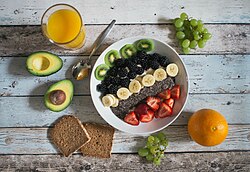Unsolved:Intuitive eating

Intuitive eating is an approach to eating that focuses on the body's response to cues of hunger and satisfaction.[2][3] It aims to foster a positive relationship with food as opposed to pursuing "weight control".[4] Additionally, intuitive eating aims to change users' views about dieting, health, and wellness, instilling a more holistic approach.[1] It also helps to create a positive attitude and relationship towards food, physical activity, and the body.[4]
The term "intuitive eating", coined by registered dietitians Evelyn Tribole and Elyse Resch, first appeared in a 1990s peer-reviewed journal article.[5] In 2012, Tribole's and Resch's book Intuitive Eating: A Revolutionary Program that Works was published, identifying ten components of intuitive eating and reviewing the scientific research that has been conducted on it.[1]
Characteristics
Unlike most diets, intuitive eating does not try to ban or restrict certain foods, with its mindset being that food should not be looked at as "good or bad". Practitioners are instead encouraged to listen to their body and eat what feels right for them.[6]
Intuitive eating follows 10 guidelines:[3][1]
- Reject the diet mentality
- Honor your hunger
- Make peace with food
- Challenge the food police
- Feel your fullness
- Discover the satisfaction factor
- Cope with your emotions without using food
- Respect your body
- Exercise
- Honor your health
Research
Weight loss and chronic disease control
Intuitive eating has been shown to be equally effective to diet intervention for short-term weight loss, and to decrease weight significantly more than in control groups that had no diet intervention.[5] Long-term weight loss from intuitive eating might be possible, but this possibility is not yet well-studied.[5]
Intuitive eating may be equally effective as a diabetes self-management education (DSME) and a lifestyle weight loss program, although further research is needed.[7]
In overweight or obese pregnant women, intuitive eating can also help lower glucose levels.[7]
Intuitive eating may help to lower cholesterol and fasting glucose levels, improve HbA1C levels, and lower systolic and diastolic blood pressure.[7][8]
Disordered eating
A 2022 review found that intuitive eating reduced disordered eating behaviors.[8]
Body acceptance
A 2022 review found that intuitive eating helped to decrease dieting and concerns about weight.[3]
A 2016 review found that it correlated with self-esteem and self-compassion.[4] Another review found that it could lead to improved quality of life, body image, and body appreciation.[4][3]
A 2019 study revealed that women who followed intuitive eating patterns were able to let go of the concepts of "good" and "bad" foods that are commonly promoted by diet culture, allowing them to eat a more balanced, sustainable, and non-restrictive diet.[9]
Drawbacks and limitations
Intuitive eating has shown growth as a possible method for losing weight and yielding health benefits. However, researchers warn that there is not enough research to support that it can assist with weight loss long-term, or with maintaining weight loss. Furthermore, doctors and registered dietitians warn that this "non-diet" diet approach will yield different results for different people.[10]
People with certain health conditions may be instructed by their doctor to follow a particular diet, eliminating the choice to follow an intuitive eating diet. Critics have also argued that because intuitive eating is so broad, with no given diet plan or food restrictions, it can be hard for some users to know what to eat and how much to eat. It can be a steep learning curve to accurately respond to one's hunger and fullness cues.[11]
See also
- Health at Every Size
- Human nutrition
- Body positivity
References
- ↑ 1.0 1.1 1.2 1.3 Tribole, Evelyn (2012). Intuitive eating- A Revolutionary Program that Works. Elyse Resch (3rd ed.). New York: St. Martin's Griffin. ISBN 978-1-250-00404-8. OCLC 793689026. https://www.worldcat.org/oclc/793689026.
- ↑ Bédard, Alexandra; Lamarche, Pierre-Olivier; Grégoire, Lucie-Maude; Trudel-Guy, Catherine; Provencher, Véronique; Desroches, Sophie; Lemieux, Simone (2020-12-21). "Can eating pleasure be a lever for healthy eating? A systematic scoping review of eating pleasure and its links with dietary behaviors and health". PLOS ONE 15 (12): e0244292. doi:10.1371/journal.pone.0244292. ISSN 1932-6203. PMID 33347469. Bibcode: 2020PLoSO..1544292B.
- ↑ 3.0 3.1 3.2 3.3 Babbott, Katie M; Cavadino, Alana; Brenton-Peters, Jennifer; Consedine, Nathan S; Roberts, Marion (2022-04-09). "Outcomes of intuitive eating interventions: a systematic review and meta-analysis". Eating Disorders 31 (1): 33–63. doi:10.1080/10640266.2022.2030124. ISSN 1064-0266. PMID 35400300. http://dx.doi.org/10.1080/10640266.2022.2030124.
- ↑ 4.0 4.1 4.2 4.3 Bruce, Lauren J.; Ricciardelli, Lina A. (January 2016). "A systematic review of the psychosocial correlates of intuitive eating among adult women". Appetite 96: 454–472. doi:10.1016/j.appet.2015.10.012. ISSN 0195-6663. PMID 26474781. http://dx.doi.org/10.1016/j.appet.2015.10.012.
- ↑ 5.0 5.1 5.2 Fuentes Artiles, Ruben; Staub, Kaspar; Aldakak, Lafi; Eppenberger, Patrick; Rühli, Frank; Bender, Nicole (August 2019). "Mindful eating and common diet programs lower body weight similarly: Systematic review and meta‐analysis". Obesity Reviews 20 (11): 1619–1627. doi:10.1111/obr.12918. ISSN 1467-7881. PMID 31368631. http://dx.doi.org/10.1111/obr.12918.
- ↑ Sreenivas, Shishira. "What Is Intuitive Eating?" (in en). https://www.webmd.com/diet/what-is-intuitive-eating.
- ↑ 7.0 7.1 7.2 Hayashi, Lauren C.; Benasi, Giada; St-Onge, Marie-Pierre; Aggarwal, Brooke (2021-12-16). "Intuitive and mindful eating to improve physiological health parameters: a short narrative review of intervention studies". Journal of Complementary and Integrative Medicine. doi:10.1515/jcim-2021-0294. ISSN 2194-6329. PMID 34913327. PMC 10098784. http://dx.doi.org/10.1515/jcim-2021-0294.
- ↑ 8.0 8.1 Hensley-Hackett, Katie; Bosker, Josephine; Keefe, Ashleigh; Reidlinger, Dianne; Warner, Molly; D’Arcy, Anna; Utter, Jennifer (October 2022). "Intuitive Eating Intervention and Diet Quality in Adults: A Systematic Literature Review". Journal of Nutrition Education and Behavior 54 (12): 1099–1115. doi:10.1016/j.jneb.2022.08.008. ISSN 1499-4046. PMID 36274010. http://dx.doi.org/10.1016/j.jneb.2022.08.008.
- ↑ Barraclough, Emma Louise; Hay-Smith, E Jean C; Boucher, Sara E; Tylka, Tracy Lynn; Horwath, Caroline Christine (2019-02-01). "Learning to eat intuitively: A qualitative exploration of the experience of mid-age women". Health Psychology Open 6 (1): 2055102918824064. doi:10.1177/2055102918824064. ISSN 2055-1029. PMID 30746153.
- ↑ "What is Intuitive Eating? 10 Principles to Follow". June 8, 2022. https://health.clevelandclinic.org/what-is-intuitive-eating/.
- ↑ "What is Intuitive Eating and Is It Healthy?" (in en). 2019-09-22. https://www.news-medical.net/health/What-is-Intuitive-Eating-and-Is-It-Healthy.aspx.
 |

